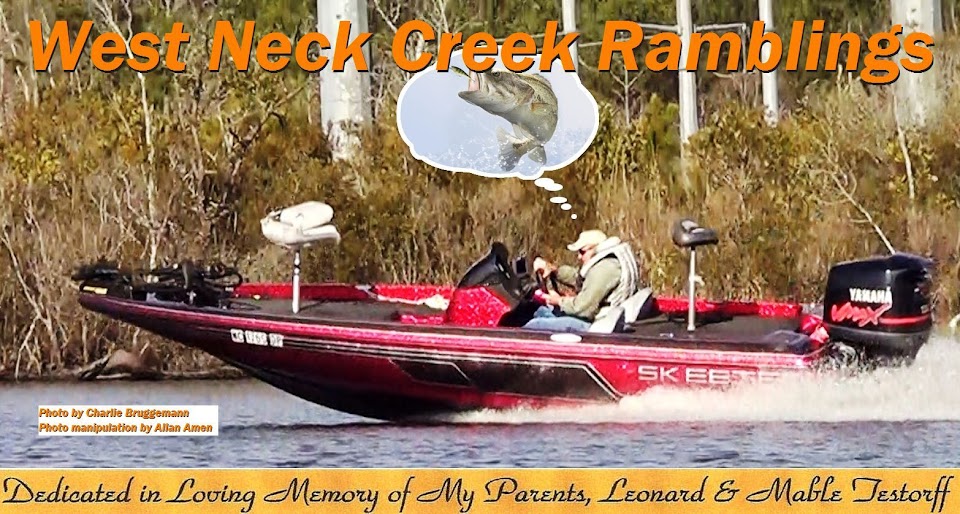I can't begin to tell you how many oh-dark-30 mornings over my lifetime I've pulled up to a spot, especially in early spring, and had goose bumps break out everywhere as I started methodically working an old jitterbug in and around cypress trees or along grassy shorelines. The adrenaline really would get to pumping when I detected, in the dimness of that early-morning light, an all-too-familiar wake following just inches behind the bait. Suddenly, then, my heart would leap into my throat, as that long-awaited C-R-R-R-A-S-H finally came, and the fight would be on. How can I ever forget those times when I was lucky, and it would be a big 'un, causing my reel's drag to scream wildly, as Bubba headed for parts unknown? That's undeniably the best feeling ever for a fisherman.
Not so much in recent years, but in earlier times, I've been blessed to have had days when I caught fish all day long on a jitterbug. And I'm here to tell you that I never ever tired of the excitement such a day brought me.
Since the birth of the Fred Arbogast jitterbug in the 1930s, many other topwater lures have come and gone. Meanwhile, the jitterbug remains on the A-list of must-have bass lures. Some anglers today turn their noses up at this timeless classic, but that's their loss. It very nicely fills the object of bass fishermen everywhere: to catch bass. Despite the fact it's neither the fanciest, nor the highest tech lure available, the jitterbug can hold its own against anything the modern world has to offer--without a doubt.
The thing that makes the jitterbug such a proven fish-catcher is its double-cupped lip at the front of the lure. That plop-plop sound coming from the lure's lip, according to some, "drives bass and other game fish absolutely insane."
The basic design and function of the jitterbug really hasn't changed much over the years. Those few alterations the lure has undergone mostly have been limited to materials and colors. First introduced as a wooden lure with a metal lip, the jitterbug was forced to make a few changes when World War II started. Metal was in short supply, so Arbogast began making both the body and the lip from plastic. Once the war ended, he reinstated the metal lip but let the plastic body remain.
As declared in one account I read, "You must fish this lure with confidence and patience, but don't be surprised when fish come swimming up to investigate your lure seconds after it hits the water. But be warned: Strikes come hard and fast, so you have to be ready to do battle from the moment the lure hits the surface."
After all these years, you still today can find the jitterbug in several different stylistic variations. Colorful plastic models with the trademark metal lip are the most common versions, but you also can find copies of the original wooden models. According to one source I discovered online, "It isn't easy to improve on perfection, and that's precisely what the Arbogast company achieved with the original wooden models of the jitterbug."
The Legendary Fred Arbogast
Born in 1894 in Ohio, Fred attended Central High School in Akron, where he excelled in athletics. He was a starting halfback on their state-champion football team. Graduating in 1913, he went to work at the relatively new Goodyear Tire and Rubber factory in Akron. When not working at the factory, he could be found fishing on the nearby Little Cuyahoga River.
Arbogast entered his first casting competition in 1916, and won the championship in the 1/2-ounce class with a distance of 162 feet--an amazing feat, considering the primitive state of baitcasting gear at the time. It's worth noting here that no spincasting reels existed at that time. They didn't appear until R. D. Hull and the Zero Hour Bomb Company (ZEBCO) invented them in 1949.
In 1922, Arbogast set the world record for distance casting in the 1/2-ounce class with a distance of more than 271 feet. He also won the 1/4-ounce class with a distance of more than 193 feet. In 1923, he set the world record for distance in the 1/4-ounce class with a cast of more than 208 feet, becoming the first person ever to win the competition two years in a row. And he didn't just win the distance competition; he also won awards for accuracy.
What makes these achievements so astounding, besides the primitive state of baitcasting reels then, was the fact there were no graphite, boron, or other high-performance rods available. Fiberglass also hadn't been invented yet. The rods were all either cane or steel. Arbogast preferred short, stiff rods 4-and-a-half or 5 feet long, with only two guides to reduce friction.
Fred also was an ace with a fly rod in both distance and accuracy. He was so proficient with any kind of rod that local tackle shops often would have him put on exhibitions, casting through hoops, breaking balloons, and even knocking cigarettes from an assistant's mouth.
 |
| Arbogast at a 1918 casting competition. |
Fred soon had to move into a larger house and hire employees to keep up with the demand and to have a full-scale factory. Among his successful designs were the Hawaiian wiggler in 1936; the hula popper, also in 1936; and the jitterbug in 1938. He also is credited with inventing the world's first rubber skirt for lures, again in 1936. All in all, he created 11 classic designs, most of which still are catching fish today, more than 80 years later.
Mr. Arbogast passed away in 1947, at the age of 53, after collapsing while ice-skating. His memory lives on, though, as do his lures.




No comments:
Post a Comment